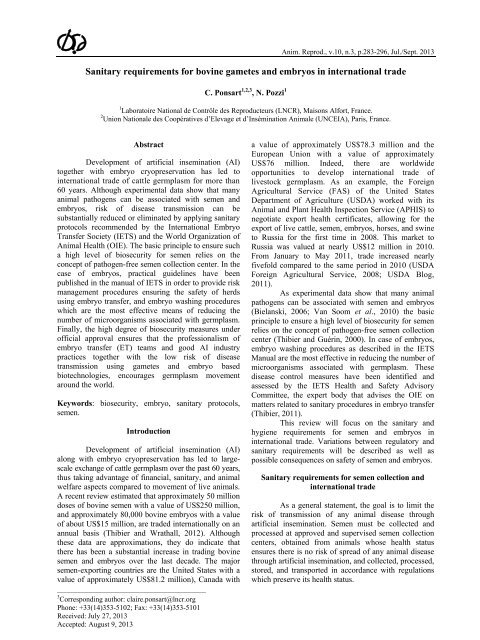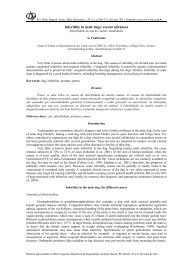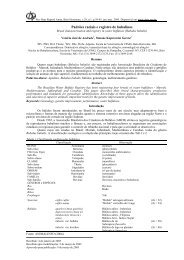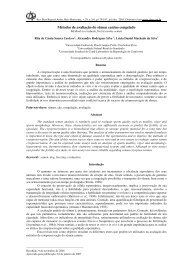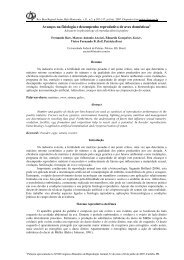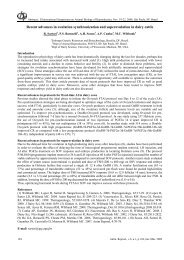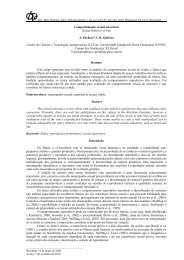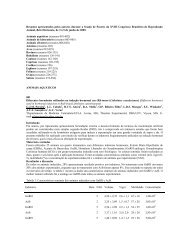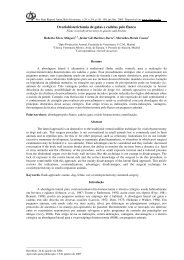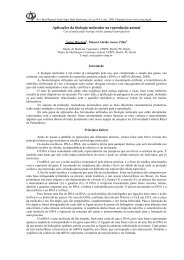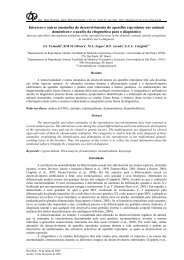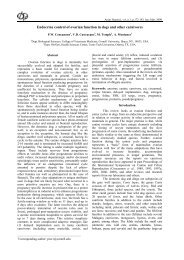Sanitary requirements for bovine gametes and embryos in ... - CBRA
Sanitary requirements for bovine gametes and embryos in ... - CBRA
Sanitary requirements for bovine gametes and embryos in ... - CBRA
Create successful ePaper yourself
Turn your PDF publications into a flip-book with our unique Google optimized e-Paper software.
Anim. Reprod., v.10, n.3, p.283-296, Jul./Sept. 2013<strong>Sanitary</strong> <strong>requirements</strong> <strong>for</strong> <strong>bov<strong>in</strong>e</strong> <strong>gametes</strong> <strong>and</strong> <strong>embryos</strong> <strong>in</strong> <strong>in</strong>ternational tradeC. Ponsart 1,2,3 , N. Pozzi 11 Laboratoire National de Contrôle des Reproducteurs (LNCR), Maisons Al<strong>for</strong>t, France.2 Union Nationale des Coopératives d’Elevage et d’Insém<strong>in</strong>ation Animale (UNCEIA), Paris, France.AbstractDevelopment of artificial <strong>in</strong>sem<strong>in</strong>ation (AI)together with embryo cryopreservation has led to<strong>in</strong>ternational trade of cattle germplasm <strong>for</strong> more than60 years. Although experimental data show that manyanimal pathogens can be associated with semen <strong>and</strong><strong>embryos</strong>, risk of disease transmission can besubstantially reduced or elim<strong>in</strong>ated by apply<strong>in</strong>g sanitaryprotocols recommended by the International EmbryoTransfer Society (IETS) <strong>and</strong> the World Organization ofAnimal Health (OIE). The basic pr<strong>in</strong>ciple to ensure sucha high level of biosecurity <strong>for</strong> semen relies on theconcept of pathogen-free semen collection center. In thecase of <strong>embryos</strong>, practical guidel<strong>in</strong>es have beenpublished <strong>in</strong> the manual of IETS <strong>in</strong> order to provide riskmanagement procedures ensur<strong>in</strong>g the safety of herdsus<strong>in</strong>g embryo transfer, <strong>and</strong> embryo wash<strong>in</strong>g procedureswhich are the most effective means of reduc<strong>in</strong>g thenumber of microorganisms associated with germplasm.F<strong>in</strong>ally, the high degree of biosecurity measures underofficial approval ensures that the professionalism ofembryo transfer (ET) teams <strong>and</strong> good AI <strong>in</strong>dustrypractices together with the low risk of diseasetransmission us<strong>in</strong>g <strong>gametes</strong> <strong>and</strong> embryo basedbiotechnologies, encourages germplasm movementaround the world.Keywords: biosecurity, embryo, sanitary protocols,semen.IntroductionDevelopment of artificial <strong>in</strong>sem<strong>in</strong>ation (AI)along with embryo cryopreservation has led to largescaleexchange of cattle germplasm over the past 60 years,thus tak<strong>in</strong>g advantage of f<strong>in</strong>ancial, sanitary, <strong>and</strong> animalwelfare aspects compared to movement of live animals.A recent review estimated that approximately 50 milliondoses of <strong>bov<strong>in</strong>e</strong> semen with a value of US$250 million,<strong>and</strong> approximately 80,000 <strong>bov<strong>in</strong>e</strong> <strong>embryos</strong> with a valueof about US$15 million, are traded <strong>in</strong>ternationally on anannual basis (Thibier <strong>and</strong> Wrathall, 2012). Althoughthese data are approximations, they do <strong>in</strong>dicate thatthere has been a substantial <strong>in</strong>crease <strong>in</strong> trad<strong>in</strong>g <strong>bov<strong>in</strong>e</strong>semen <strong>and</strong> <strong>embryos</strong> over the last decade. The majorsemen-export<strong>in</strong>g countries are the United States with avalue of approximately US$81.2 million), Canada with_________________________________________3 Correspond<strong>in</strong>g author: claire.ponsart@lncr.orgPhone: +33(14)353-5102; Fax: +33(14)353-5101Received: July 27, 2013Accepted: August 9, 2013a value of approximately US$78.3 million <strong>and</strong> theEuropean Union with a value of approximatelyUS$76 million. Indeed, there are worldwideopportunities to develop <strong>in</strong>ternational trade oflivestock germplasm. As an example, the ForeignAgricultural Service (FAS) of the United StatesDepartment of Agriculture (USDA) worked with itsAnimal <strong>and</strong> Plant Health Inspection Service (APHIS) tonegotiate export health certificates, allow<strong>in</strong>g <strong>for</strong> theexport of live cattle, semen, <strong>embryos</strong>, horses, <strong>and</strong> sw<strong>in</strong>eto Russia <strong>for</strong> the first time <strong>in</strong> 2008. This market toRussia was valued at nearly US$12 million <strong>in</strong> 2010.From January to May 2011, trade <strong>in</strong>creased nearlyfivefold compared to the same period <strong>in</strong> 2010 (USDAForeign Agricultural Service, 2008; USDA Blog,2011).As experimental data show that many animalpathogens can be associated with semen <strong>and</strong> <strong>embryos</strong>(Bielanski, 2006; Van Soom et al., 2010) the basicpr<strong>in</strong>ciple to ensure a high level of biosecurity <strong>for</strong> semenrelies on the concept of pathogen-free semen collectioncenter (Thibier <strong>and</strong> Guér<strong>in</strong>, 2000). In case of <strong>embryos</strong>,embryo wash<strong>in</strong>g procedures as described <strong>in</strong> the IETSManual are the most effective <strong>in</strong> reduc<strong>in</strong>g the number ofmicroorganisms associated with germplasm. Thesedisease control measures have been identified <strong>and</strong>assessed by the IETS Health <strong>and</strong> Safety AdvisoryCommittee, the expert body that advises the OIE onmatters related to sanitary procedures <strong>in</strong> embryo transfer(Thibier, 2011).This review will focus on the sanitary <strong>and</strong>hygiene <strong>requirements</strong> <strong>for</strong> semen <strong>and</strong> <strong>embryos</strong> <strong>in</strong><strong>in</strong>ternational trade. Variations between regulatory <strong>and</strong>sanitary <strong>requirements</strong> will be described as well aspossible consequences on safety of semen <strong>and</strong> <strong>embryos</strong>.<strong>Sanitary</strong> <strong>requirements</strong> <strong>for</strong> semen collection <strong>and</strong><strong>in</strong>ternational tradeAs a general statement, the goal is to limit therisk of transmission of any animal disease throughartificial <strong>in</strong>sem<strong>in</strong>ation. Semen must be collected <strong>and</strong>processed at approved <strong>and</strong> supervised semen collectioncenters, obta<strong>in</strong>ed from animals whose health statusensures there is no risk of spread of any animal diseasethrough artificial <strong>in</strong>sem<strong>in</strong>ation, <strong>and</strong> collected, processed,stored, <strong>and</strong> transported <strong>in</strong> accordance with regulationswhich preserve its health status.
Ponsart <strong>and</strong> Pozzi. <strong>Sanitary</strong> <strong>requirements</strong> <strong>for</strong> <strong>gametes</strong> <strong>and</strong> <strong>embryos</strong>.General <strong>requirements</strong>: <strong>in</strong>dustry self-regulation,approval, <strong>and</strong> official supervisionIn the world, general <strong>requirements</strong> aredescribed <strong>in</strong> the OIE Terrestrial code <strong>for</strong> semencollection, process<strong>in</strong>g, <strong>and</strong> storage centers (SCC = SemenCollection Center; SSC = Semen Storage Center) <strong>in</strong> twodedicated chapters (OIE, 2012; Chapters 4.5 <strong>and</strong> 4.6).Some differences exist among the<strong>requirements</strong> of the OIE, Certified Semen Services(CSS) or European Union (EU) as <strong>for</strong> example,frequency of audits, scheduled once or twice a year(Table 1), <strong>and</strong> the approval procedure or thesupervision, which may be assumed directly by officialveter<strong>in</strong>arians or partly delegated to self-control<strong>in</strong>stitutes.Table 1. General <strong>requirements</strong> <strong>for</strong> veter<strong>in</strong>ary <strong>and</strong> official supervision.ReferencesRequirementsOIE <strong>requirements</strong>AI center officially approved by the Veter<strong>in</strong>ary Authority.• under the supervision <strong>and</strong> control of the Veter<strong>in</strong>ary Services which will beOIE, 2012 (Chapter 4.5)responsible <strong>for</strong> regular audits, at an <strong>in</strong>terval of no more than 12 months, ofprotocols, procedures <strong>and</strong> records on the health <strong>and</strong> welfare of the animals<strong>in</strong> the center <strong>and</strong> on the hygienic production, storage <strong>and</strong> dispatch of semen.CSS <strong>requirements</strong>Certified Semen Services - CSS,2011a (Agreement)Certified Semen Services - CSS,2011b (AI center animal)EU <strong>requirements</strong>European Union, 1988 (CouncilDirective 88/407/EEC)AI center, under the direct supervision <strong>and</strong> control of a center veter<strong>in</strong>arian.• AI Center (Stud) code number assigned by the National Association ofAnimal Breeders;• annual Semen Identification Audit by a representative of CSS <strong>and</strong>possibly an accompany<strong>in</strong>g representative from USDA, with access to allphases of semen production <strong>and</strong> related identification functions;• additional USDA-APHIS Certificate <strong>for</strong> the approval <strong>in</strong> accordance withCouncil Directive 88/407/EEC of a semen collection center.All approved semen collection centers (SCC) registered, with a veter<strong>in</strong>aryregistration number.• list of SCCs <strong>and</strong> their veter<strong>in</strong>ary registration numbers sent to theCommission (Decision 2007/846/EC);• notification of any withdrawal of approval;• <strong>in</strong>spections by an official veter<strong>in</strong>arian, at least twice a year, at whichtime st<strong>and</strong><strong>in</strong>g checks on the conditions of approval <strong>and</strong> supervision shallbe carried out.SCC under the permanent supervision of a center veter<strong>in</strong>arian.With<strong>in</strong> the EU, Article 3(a) of CouncilDirective 88/407/EEC (European Union - EU, 1988)requires SCCs <strong>and</strong> SSCs to be approved, when theycollect or store semen which may enter <strong>in</strong>tra-communitytrade. The same applies to embryo collection teams orembryo production teams, accord<strong>in</strong>g to Article 3(C) ofDirective 89/556/EEC. Article 5 <strong>in</strong> each Directiverequires that each center, or team, is given a veter<strong>in</strong>aryregistration number, <strong>and</strong> that the approval conditions areunder official supervision. An updated list of approvedteams <strong>and</strong> centers must be sent to the other MemberStates (as described <strong>in</strong> Decision 2007/846/EC).The Food <strong>and</strong> Veter<strong>in</strong>ary Office (FVO) worksto assure effective control systems <strong>and</strong> to evaluatecompliance with st<strong>and</strong>ards with<strong>in</strong> the EU, <strong>and</strong> <strong>in</strong> thirdcountries <strong>in</strong> relation to their exports to the EU. TheFVO does this ma<strong>in</strong>ly by carry<strong>in</strong>g out <strong>in</strong>spections <strong>in</strong>Member States <strong>and</strong> <strong>in</strong> third countries export<strong>in</strong>g to theEU. Each year the FVO develops an <strong>in</strong>spectionprogram, identify<strong>in</strong>g priority areas <strong>and</strong> countries <strong>for</strong><strong>in</strong>spection. In order to ensure that the program rema<strong>in</strong>sup-to-date <strong>and</strong> relevant, it is reviewed mid-year. Theseprograms are published on a website (http://ec.europa.eu/food/fvo/<strong>in</strong>dex_en.cfm). The f<strong>in</strong>d<strong>in</strong>gs of each <strong>in</strong>spectioncarried out under the program are set out <strong>in</strong> an<strong>in</strong>spection report, together with conclusions <strong>and</strong>recommendations. The competent authority of thecountry visited is given the opportunity to comment onthe reports at draft stage.Certified Semen Services (CSS), Inc., is awholly owned subsidiary of the National Association ofAnimal Breeders (NAAB) <strong>in</strong> the USA. The CSSprogram has enabled the national animal breed<strong>in</strong>g<strong>in</strong>dustry to regulate itself without the direct government<strong>in</strong>volvement. CSS is organized so that any AI bus<strong>in</strong>essengaged <strong>in</strong> collection <strong>and</strong> process<strong>in</strong>g of livestock semenis eligible to participate <strong>in</strong> <strong>and</strong> benefit from its servicesprogram upon enter<strong>in</strong>g an agreement <strong>for</strong> services. TheCSS Service Director annually makes at least oneunannounced audit visit to the offices <strong>and</strong> semenproduction facilities of each participat<strong>in</strong>g AI bus<strong>in</strong>ess.Dur<strong>in</strong>g the audit visit, procedures <strong>and</strong> records related to284 Anim. Reprod., v.10, n.3, p.283-296, Jul./Sept. 2013
Ponsart <strong>and</strong> Pozzi. <strong>Sanitary</strong> <strong>requirements</strong> <strong>for</strong> <strong>gametes</strong> <strong>and</strong> <strong>embryos</strong>.Technical staff <strong>and</strong> animal managementAs mentioned <strong>in</strong> the OIE Animal Health Code,the laboratory personnel should be technically competent<strong>and</strong> observe high st<strong>and</strong>ards of personal hygiene topreclude the <strong>in</strong>troduction of pathogenic organisms dur<strong>in</strong>gsemen evaluation, process<strong>in</strong>g, <strong>and</strong> storage. In CSS(2011b; AI center animal management guidel<strong>in</strong>es),complete recommendations <strong>for</strong> animal management, sire<strong>and</strong> hygiene procedures, feed<strong>in</strong>g <strong>and</strong> hous<strong>in</strong>g conditions<strong>and</strong> veter<strong>in</strong>ary <strong>and</strong> professional care are described.Specific sanitary <strong>requirements</strong> <strong>for</strong> <strong>bov<strong>in</strong>e</strong> semenIn general terms, microorganisms can be present<strong>in</strong> the semen of an <strong>in</strong>fected male or can ga<strong>in</strong> entry to semendur<strong>in</strong>g collection, process<strong>in</strong>g, or storage. In order toma<strong>in</strong>ta<strong>in</strong> a controlled status of semen batches, tests must beapplied on semen <strong>and</strong> genital tract, semen production, <strong>and</strong>sanitary control of the bulls present <strong>in</strong> the center.For given pathogenic agents, semen can becertified as free if the donor bull orig<strong>in</strong>ated from a freeherd, the dam of the bull is free, the donor bull is free,the donor bull is <strong>in</strong>troduced to a center where all otherbulls are free, <strong>and</strong> all the bulls present <strong>in</strong> the center aresubmitted to regular tests regard<strong>in</strong>g this agent. For eachagent, specific OIE <strong>requirements</strong> aim to ma<strong>in</strong>ta<strong>in</strong> thehealth of animals on an artificial <strong>in</strong>sem<strong>in</strong>ation center ata level which permits the <strong>in</strong>ternational distribution ofsemen with a negligible risk of <strong>in</strong>fect<strong>in</strong>g other animalsor humans with pathogens transmissible by semen, asdescribed <strong>in</strong> the Table 4.<strong>Sanitary</strong> <strong>requirements</strong> <strong>for</strong> <strong>embryos</strong> used <strong>in</strong><strong>in</strong>ternational tradeAlthough transfer of <strong>bov<strong>in</strong>e</strong> <strong>embryos</strong> is muchless likely to result <strong>in</strong> disease transmission than transport oflive animals (Thibier <strong>and</strong> Wrathall, 2012), the sanitary riskassociated with <strong>bov<strong>in</strong>e</strong> embryo transfer rema<strong>in</strong>s the subjectof scientific <strong>in</strong>vestigations (Van Soom et al., 2008) <strong>and</strong>adaptations of national <strong>and</strong> <strong>in</strong>ternational legislations (OIE,2012; Chapters 4.7 <strong>and</strong> 4.8).Physiological backgroundInteraction of oocytes <strong>and</strong> <strong>embryos</strong> withpathogenic agents has been extensively reviewed byBielanski (2006). Oocytes <strong>and</strong> early embryo stages up toapproximately day 8 after fertilization, are surrounded byan acellular glycoprote<strong>in</strong> shell with a sponge-like surface,the zona pellucida (ZP). Visualized by scann<strong>in</strong>g electronmicroscopy, the ZP is composed of a fibrous networkwith numerous pores. The pores are larger at the outersurface (outer diameter of <strong>embryos</strong> range from 155 to223 µm <strong>for</strong> different embryonic developmental stages)but decrease <strong>in</strong> size centripetally <strong>in</strong> both animals <strong>and</strong>human <strong>embryos</strong> (Bielanski, 2006). Such anatomicalstructures of the ZP allows <strong>for</strong> adhesion of pathogens, butprevents them from fully penetrat<strong>in</strong>g the ZP.S<strong>in</strong>ce the ZP is acellular <strong>in</strong> character, viruses arenot able to replicate there <strong>and</strong> they must cross the ZP <strong>and</strong>the cell plasma membrane to <strong>in</strong>fect an embryo. In general,ova or <strong>embryos</strong> can become contam<strong>in</strong>ated at differentstages: be<strong>for</strong>e the ZP is <strong>for</strong>med (under physiologicalconditions, the ZP is <strong>for</strong>med <strong>in</strong> the ovarian preantralsecondary follicles), later by agents present <strong>in</strong> thefollicular fluid, by pathogen-contam<strong>in</strong>ated semen dur<strong>in</strong>gfertilization or dur<strong>in</strong>g passage through the oviduct <strong>and</strong> theuterus, even if <strong>in</strong>tegrity of the ZP prevents contam<strong>in</strong>ationof embryonic cells <strong>for</strong> most pathogens (Bielanski, 2006;Van Soom et al., 2008). With the application of <strong>in</strong> vitrofertilization techniques, immature oocytes surrounded bya multilayer of compacted granulosa cells (cumulusoocytecomplexes) are collected from ovarian folliclesus<strong>in</strong>g Ovum Pick Up (OPU) or from slaughterhousederived ovaries <strong>and</strong> placed <strong>in</strong> the maturation medium.Dur<strong>in</strong>g this period, the granulosa cells become exp<strong>and</strong>ed<strong>and</strong> their connections with the ZP loosen. Later, thegranulosa cells are mechanically removed, delet<strong>in</strong>g theconnection between these cells <strong>and</strong> the ZP. Specific risksare l<strong>in</strong>ked to artificial culture conditions, rather than theutero-tubal environment which occurs with <strong>in</strong> vivofertilization (Bielanski, 2006).Requirements applied to <strong>in</strong> vivo derived <strong>embryos</strong>Assessment of disease transmission via <strong>in</strong> vivoderived <strong>embryos</strong>Experience <strong>and</strong> experimental evidence has<strong>in</strong>dicated a low potential <strong>for</strong> transmission of <strong>in</strong>fectiouspathogens via <strong>in</strong> vivo-derived (IVD) <strong>embryos</strong> (Givens etal., 2007; Thibier 2011). Pathogens may be shed <strong>in</strong>to thegenital tract <strong>and</strong> contam<strong>in</strong>ate the surface of <strong>embryos</strong>, ifthose pathogens are present at the time of collection orbetween fertilization <strong>and</strong> collection. Scientific reflectionson the sanitary risks associated with ET have focused onthe probability that <strong>embryos</strong> can be contam<strong>in</strong>ated either viathe oocyte, the semen, or adhesion to the zona pellucida.There have been many <strong>in</strong>vestigations to evaluate<strong>in</strong>teractions between pathogens <strong>and</strong> <strong>embryos</strong>, us<strong>in</strong>gdifferent <strong>in</strong> vivo or <strong>in</strong> vitro <strong>in</strong>fection approaches (Table 5).In vivo approaches are the most suitable toevaluate the likelihood of transmission through embryotransfer, however such experiments require expensiveprotocols <strong>in</strong> order to <strong>in</strong>fect donor animals <strong>and</strong> per<strong>for</strong>msubsequent transfer to recipients. As an example, facilitieswith a controlled environment <strong>and</strong> that are <strong>in</strong>sect-proof arerequired to <strong>in</strong>vestigate vector transmitted diseases. Fordiseases with a long <strong>in</strong>cubation period (e.g., prions),experiments may last several years. Complementary <strong>in</strong>vitro approaches can be used to ga<strong>in</strong> knowledge withmore accessible costs (Table 5). Indeed, <strong>in</strong> vitroexperiments are ultimately more conservative <strong>and</strong> arenot as likely to be <strong>in</strong>fluenced by factors like m<strong>in</strong>imum<strong>in</strong>fective dose, <strong>in</strong>nate immunity etc. Realistically, if an <strong>in</strong>vitro experiment does not reveal the presence of <strong>in</strong>fectiousagents, the likelihood of an <strong>in</strong> vivo experiment show<strong>in</strong>g itspresence is very unlikely.Anim. Reprod., v.10, n.3, p.283-296, Jul./Sept. 2013 287
Ponsart <strong>and</strong> Pozzi. <strong>Sanitary</strong> <strong>requirements</strong> <strong>for</strong> <strong>gametes</strong> <strong>and</strong> <strong>embryos</strong>.Table 4. Specific OIE <strong>requirements</strong> <strong>for</strong> <strong>in</strong>ternational distribution of semen with a negligible risk of <strong>in</strong>fect<strong>in</strong>g otheranimals or humans with pathogens transmissible by semen (OIE, 2012).DiseasesSemenBov<strong>in</strong>e Brucellosis(BB)*• semen from an AI center: test<strong>in</strong>g program with the buffered Brucella antigen (roseBengal test; RBT) <strong>and</strong> complement fixation tests (CFT);• semen not issued from an AI center: country or zone free from BB; or herd officially freefrom BB, no cl<strong>in</strong>ical sign of BB on the day of collection of the semen <strong>and</strong> animalssubjected to a RBT with negative results over the 30 days prior to collection; or herd freefrom BB, no cl<strong>in</strong>ical sign of BB on the day of collection <strong>and</strong> animals subjected to RBT<strong>and</strong> CFT with negative results dur<strong>in</strong>g the 30 days prior to collection.Bov<strong>in</strong>e GenitalCampylobacteriosis(BGC)Bov<strong>in</strong>e Tuberculosis(BT)*Bov<strong>in</strong>e Tuberculosis(BT) <strong>in</strong> farmedcervidae*Blue Tongue Virus(BTV)Bov<strong>in</strong>e ViralDiarrhea (BVD)Contagious Bov<strong>in</strong>ePleuropneumonia(CBPP)*• donor animals have never been used <strong>for</strong> natural service; or have only mated virg<strong>in</strong>heifers; or kept <strong>in</strong> an establishment or AI center where no case of BGC has beenreported; culture of semen <strong>and</strong> preputial specimens <strong>for</strong> the presence of the causalagent of BGC proved negative.• donor animals without any sign of BT on the day of collection of the semen <strong>and</strong> either:kept <strong>in</strong> an AI center free from BT <strong>in</strong> a country, zone or compartment free from BT <strong>and</strong>which only accepts animals from free herds <strong>in</strong> a free country, zone or compartment; ornegative results to tubercul<strong>in</strong> tests carried out annually <strong>and</strong> kept <strong>in</strong> a herd free from BT.• no sign of BT <strong>in</strong> any species on the day of collection of the semen; <strong>and</strong> either: herd freefrom BT <strong>in</strong> a country, zone or compartment free from BT of farmed cervidae, <strong>and</strong> whichonly accepts animals from free herds <strong>in</strong> a free country, zone or compartment; or negativeresults to tubercul<strong>in</strong> tests carried out annually <strong>and</strong> were kept <strong>in</strong> a herd free from BT.• animals kept <strong>in</strong> a BTV free country or zone <strong>for</strong> at least 60 days be<strong>for</strong>ecommencement of, <strong>and</strong> dur<strong>in</strong>g, collection of the semen; or subjected to a serologicaltest between 21 <strong>and</strong> 60 days after the last collection, with negative results; orsubjected to an agent identification test on blood samples collected atcommencement <strong>and</strong> conclusion of, <strong>and</strong> at least every 7 days (virus isolation test) orat least every 28 days (PCR test) dur<strong>in</strong>g semen collection, with negative results.• animals subjected to a virus isolation test or a test <strong>for</strong> virus antigen, with negativeresults. Only when all the animals <strong>in</strong> pre-entry isolation have had negative results,may the animals enter the semen collection facilities;• animals subjected to a serological test to determ<strong>in</strong>e the presence or absence of BVDantibodies. Only if no seroconversion occurs <strong>in</strong> the animals which testedseronegative be<strong>for</strong>e entry <strong>in</strong>to the pre-entry isolation facility, may any animal(seronegative or seropositive) be allowed entry <strong>in</strong>to the semen collection facilities;• if seroconversion occurs, all the animals that rema<strong>in</strong> seronegative should be kept <strong>in</strong> preentryisolation until there is no more seroconversion <strong>in</strong> the group <strong>for</strong> a period of 3 weeks.Serologically positive animals may be allowed entry <strong>in</strong>to the semen collection facilities;• animals negative to previous serological tests should be retested to confirm absenceof antibodies. Should an animal become serologically positive, every ejaculate ofthat animal collected s<strong>in</strong>ce the last negative test should be either discarded or tested<strong>for</strong> virus with negative results.• from CBPP free countries, zones or compartments**: donor animals without cl<strong>in</strong>icalsign of CBPP on the day of collection of the semen; kept <strong>in</strong> a CBPP free countrys<strong>in</strong>ce birth or <strong>for</strong> at least the past 6 months;.• from CBPP <strong>in</strong>fected countries or zones: no cl<strong>in</strong>ical sign of CBPP on the day ofcollection of the semen; animals subjected to the CFT <strong>for</strong> CBPP with negativeresults, on two occasions (<strong>in</strong>terval between each test from 21 to 30 days, the secondtest with<strong>in</strong> 14 days prior to collection); isolated from other domestic bovidae fromthe day of the first CFT until collection; kept s<strong>in</strong>ce birth, or <strong>for</strong> the past six months,<strong>in</strong> an establishment where no case of CBPP was reported dur<strong>in</strong>g that period, <strong>and</strong> thatthe establishment was not situated <strong>in</strong> a CBPP <strong>in</strong>fected zone; AND EITHER: notbeen vacc<strong>in</strong>ated aga<strong>in</strong>st CBPP; OR vacc<strong>in</strong>ated us<strong>in</strong>g a vacc<strong>in</strong>e comply<strong>in</strong>g with thest<strong>and</strong>ards described <strong>in</strong> the TM not more than 4 months prior to collection.288 Anim. Reprod., v.10, n.3, p.283-296, Jul./Sept. 2013
Ponsart <strong>and</strong> Pozzi. <strong>Sanitary</strong> <strong>requirements</strong> <strong>for</strong> <strong>gametes</strong> <strong>and</strong> <strong>embryos</strong>.Enzootic Bov<strong>in</strong>eLeucosis (EBL)*Foot <strong>and</strong> MouthDisease (FMD)Infectious Bov<strong>in</strong>eRh<strong>in</strong>otracheitis/Infectious PustularVulvovag<strong>in</strong>itis *(IBR-IPV)Lumpy Sk<strong>in</strong> Disease*(LSD; caused bygroup III virus, typeNeethl<strong>in</strong>g)• donor bull resident at the time of semen collection <strong>in</strong> an EBL free herd; <strong>and</strong> if lessthan 2 years of age, the bull came from a serologically negative ‘uter<strong>in</strong>e’ dam; orbull subjected to diagnostic tests <strong>for</strong> EBL on blood samples on two occasions withnegative results (first test at least 30 days be<strong>for</strong>e <strong>and</strong> the second test at least 90 daysafter semen collection).FMD free countries• with no cl<strong>in</strong>ical signs of FMD on the day of collection of semen <strong>and</strong> <strong>for</strong> thefollow<strong>in</strong>g 30 days;• animals kept <strong>for</strong> at least 3 months prior to collection <strong>in</strong> an FMD free country or zonewithout vacc<strong>in</strong>ation or a FMD free compartment;FMD <strong>in</strong>fected countries• no cl<strong>in</strong>ical sign of FMD on the day of collection of the semen;• animals kept <strong>in</strong> an establishment where no animal had been added <strong>in</strong> the 30 daysbe<strong>for</strong>e collection, <strong>and</strong> that FMD has not occurred with<strong>in</strong> 10 kilometers <strong>for</strong> the 30 daysbe<strong>for</strong>e <strong>and</strong> after collection;• have not been vacc<strong>in</strong>ated <strong>and</strong> were subjected, not less than 21 days after collectionof the semen, to tests <strong>for</strong> antibodies aga<strong>in</strong>st FMD virus, with negative results; or hadbeen vacc<strong>in</strong>ated at least twice (last vacc<strong>in</strong>ation not more than 12 <strong>and</strong> not less thanone month prior to collection);• no other animal present <strong>in</strong> the artificial <strong>in</strong>sem<strong>in</strong>ation center has been vacc<strong>in</strong>atedwith<strong>in</strong> the month prior to collection;• the semen subjected, with negative results, to a test <strong>for</strong> FMDV <strong>in</strong>fection (if donoranimal vacc<strong>in</strong>ated with<strong>in</strong> the 12 months prior to collection); stored <strong>in</strong> the country o<strong>for</strong>ig<strong>in</strong> <strong>for</strong> a period of at least one month follow<strong>in</strong>g collection, <strong>and</strong> that dur<strong>in</strong>g thisperiod no animal on the establishment showed any sign of FMD.• Fresh semen: IBR/IPV free herd at the time of collection of the semen;• Frozen semen: IBR/IPV free herd at the time of collection of the semen; or donoranimals <strong>in</strong> isolation dur<strong>in</strong>g the period of collection <strong>and</strong> <strong>for</strong> the 30 days follow<strong>in</strong>gcollection <strong>and</strong> subjected to a diagnostic test <strong>for</strong> IBR/IPV on a blood sample taken atleast 21 days after collection of the semen, with negative results; or if unknownserological status of the bull or positive serology, an aliquot of each semencollection subjected to a virus isolation test or PCR, per<strong>for</strong>med <strong>in</strong> accordance withthe TM, with negative results.• from LSD free countries (cattle <strong>and</strong> water buffaloes): no cl<strong>in</strong>ical sign of LSD on theday of collection of the semen; kept <strong>for</strong> at least 28 days prior to collection <strong>in</strong> an LSDfree country;• from countries considered <strong>in</strong>fected with LSD: no cl<strong>in</strong>ical sign of LSD on the day ofsemen collection (SC) <strong>and</strong> <strong>for</strong> the follow<strong>in</strong>g 28 days; kept <strong>in</strong> the export<strong>in</strong>g country<strong>for</strong> the 28 days prior to SC, <strong>in</strong> an establishment or AI center where no official caseof LSD dur<strong>in</strong>g that period, <strong>and</strong> establishment or AI center was not situated <strong>in</strong> anLSD <strong>in</strong>fected zone; <strong>and</strong> either: vacc<strong>in</strong>ated aga<strong>in</strong>st LSD (28 to 90 days be<strong>for</strong>e SC <strong>and</strong>thereafter vacc<strong>in</strong>ated annually); or tested with negative results us<strong>in</strong>g a serumneutralization test (SNT) or an <strong>in</strong>direct enzyme-l<strong>in</strong>ked immunosorbent assay(ELISA) <strong>for</strong> LSD on the day of first or up to 90 days after last SC; or stableseropositivity (not more than a two-fold rise <strong>in</strong> titre) on paired samples (tested sideby side) to <strong>in</strong>direct ELISA or SNT carried out <strong>in</strong> quarant<strong>in</strong>e, 28-60 days apart (firstsample taken on the day of first SC).Trichomonosis* • donor animals never been used <strong>for</strong> natural service; or have only mated virg<strong>in</strong>heifers; or kept <strong>in</strong> an establishment or AI center where no case of trichomonosis hasbeen reported; animals subjected to a direct microscopic <strong>and</strong> culture of preputialspecimens with negative results.*For each listed disease, Veter<strong>in</strong>ary Authorities of import<strong>in</strong>g countries should require the presentation of an<strong>in</strong>ternational veter<strong>in</strong>ary certificate attest<strong>in</strong>g that the semen was collected, processed, <strong>and</strong> stored <strong>in</strong> con<strong>for</strong>mity withthe provisions of Chapters 4.5 <strong>and</strong> 4.6. **Compartment means an animal subpopulation conta<strong>in</strong>ed <strong>in</strong> one or moreestablishments under a common biosecurity management system with a dist<strong>in</strong>ct health status with respect to aspecific disease or specific diseases <strong>for</strong> which required surveillance, control, <strong>and</strong> biosecurity measures have beenapplied <strong>for</strong> the purpose of <strong>in</strong>ternational trade.Anim. Reprod., v.10, n.3, p.283-296, Jul./Sept. 2013 289
Ponsart <strong>and</strong> Pozzi. <strong>Sanitary</strong> <strong>requirements</strong> <strong>for</strong> <strong>gametes</strong> <strong>and</strong> <strong>embryos</strong>.Table 5. Assessment of the sanitary risk <strong>for</strong> <strong>in</strong> vivo derived <strong>embryos</strong> us<strong>in</strong>g scientific approaches.In vivo <strong>in</strong>fectionIn vitro <strong>in</strong>fectionIn vivo embryotransfer• naturally <strong>in</strong>fected donor or <strong>in</strong>sem<strong>in</strong>ationwith <strong>in</strong>fected semen;••experimentally spiked <strong>embryos</strong>/semen;<strong>embryos</strong> transferred to recipients.In vitro embryowash<strong>in</strong>g• Embryos transferred to recipients.• naturally <strong>in</strong>fected donor or <strong>in</strong>sem<strong>in</strong>ationwith <strong>in</strong>fected semen;• embryo status analyzed after wash<strong>in</strong>gprocedure described <strong>in</strong> IETS Manual.• experimentally spiked <strong>embryos</strong>/semen;• embryo status analyzed after wash<strong>in</strong>gprocedure <strong>in</strong> IETS Manual.Concern<strong>in</strong>g transmission risk via ET, the IETSHASAC Committee reviews scientific publications onan annual basis <strong>and</strong> updates a complete set of more than400 references, which can be consulted on their website(www.iets.org). In the <strong>bov<strong>in</strong>e</strong> species, 89 potentialembryo pathogens have been <strong>in</strong>vestigated (Thibier,2011). All diseases <strong>and</strong> pathogenic agents have beenplaced <strong>in</strong>to one of four categories based on the amountof research <strong>in</strong>dicat<strong>in</strong>g the likelihood of disease controlthrough the use of embryo transfer (Table 6). Forcategory 1 diseases, risk of transmission of a givendisease from donor to recipient via an embryo isnegligible, provid<strong>in</strong>g biosecurity measures described<strong>for</strong> h<strong>and</strong>l<strong>in</strong>g <strong>embryos</strong>, material dis<strong>in</strong>fection, <strong>and</strong> animalhealth <strong>requirements</strong> (semen, donor, <strong>and</strong> recipients ) asdescribed <strong>in</strong> the IETS Manual have been respected(Str<strong>in</strong>gfellow, 2010; Thibier, 2011).New questions have been raised regard<strong>in</strong>gtryps<strong>in</strong> treatments: Al Ahmad et al. (2012) compared atreatment st<strong>and</strong>ard (TS) comprised of phosphate-bufferedsal<strong>in</strong>e (PBS), 0.4% BSA (five washes of 100 fold dilution<strong>for</strong> 10 sec each), followed by two treatments with 0.25%tryps<strong>in</strong> <strong>in</strong> Hank’s solution (45 sec each), <strong>and</strong> then PBS0.4% BSA aga<strong>in</strong> (five times <strong>for</strong> 10 sec). The four otherwash<strong>in</strong>g procedures all <strong>in</strong>cluded the same first <strong>and</strong> lastwash<strong>in</strong>g steps with PBS but without BSA (five times <strong>for</strong>10 sec) <strong>and</strong> with PBS 0.4% BSA (five times <strong>for</strong> 10 sec),respectively. The <strong>in</strong>termediate step varied <strong>for</strong> each wash<strong>in</strong>gprocedure, with other tryps<strong>in</strong> treatments (longer time, twice<strong>for</strong> 60 sec) or hyaluronidase treatments <strong>in</strong> order toelim<strong>in</strong>ate Blue tongue virus (BTV) from <strong>in</strong> vitro <strong>in</strong>fectedgoat <strong>embryos</strong>: only two tryps<strong>in</strong> treatments of 60 sec eachwas effective <strong>in</strong> remov<strong>in</strong>g BTV from the <strong>embryos</strong>.Legal <strong>and</strong> sanitary measures applied to <strong>in</strong> vivoderived <strong>embryos</strong>Practical guidel<strong>in</strong>es have been published <strong>in</strong> theManual of the International Embryo Transfer Society <strong>in</strong>order to provide risk management procedures ensur<strong>in</strong>gthe safety of ET (Str<strong>in</strong>gfellow, 2010). S<strong>in</strong>ce theseguidel<strong>in</strong>es have been adopted by the OIE, they are wellaccepted <strong>and</strong> implemented worldwide (OIE, 2012;Chapter 4.7). In Europe, legislation prescribes thesanitary conditions to which embryo collection <strong>and</strong>transfer should comply. The Council Directive89/556/EEC of 25 September 1989 describes animalhealth conditions govern<strong>in</strong>g <strong>in</strong>tra-community trade <strong>in</strong><strong>and</strong> importation from third countries of <strong>embryos</strong> derivedfrom the <strong>bov<strong>in</strong>e</strong> species. The legislation def<strong>in</strong>es sanitary<strong>and</strong> biosecurity <strong>requirements</strong> <strong>in</strong>clud<strong>in</strong>g donor females,environmental <strong>and</strong> h<strong>and</strong>l<strong>in</strong>g conditions, <strong>and</strong> semen used<strong>for</strong> donor <strong>in</strong>sem<strong>in</strong>ation.• <strong>Sanitary</strong> <strong>requirements</strong>In addition to OIE recommendations (Table 7),EU legislation <strong>in</strong>cludes the follow<strong>in</strong>g <strong>requirements</strong>:donor cows must have spent the previous 6 monthswith<strong>in</strong> community territory or <strong>in</strong> the third country ofcollection <strong>in</strong> a herd officially tuberculosis <strong>and</strong> brucellosisfree, enzootic <strong>bov<strong>in</strong>e</strong> leucosis free (or no cl<strong>in</strong>ical signs ofenzootic <strong>bov<strong>in</strong>e</strong> leucosis dur<strong>in</strong>g the previous 3 years);<strong>and</strong> where no cl<strong>in</strong>ical signs of <strong>in</strong>fectious <strong>bov<strong>in</strong>e</strong>rh<strong>in</strong>otracheitis/<strong>in</strong>fectious pustular vulvo-vag<strong>in</strong>itis havebeen observed dur<strong>in</strong>g the previous year.• Environmental <strong>and</strong> h<strong>and</strong>l<strong>in</strong>g conditionsBoth the OIE Terrestrial Code (Chapter 4.7)<strong>and</strong> Directive 89/556 <strong>in</strong>clude biosecurity measures basedon a team approved by competent authority (governmentor local veter<strong>in</strong>ary authorities), supervised by a teamveter<strong>in</strong>arian responsible <strong>for</strong> all team operations (healthstatus of donor cows, appropriate disease control measureswith h<strong>and</strong>l<strong>in</strong>g <strong>and</strong> operat<strong>in</strong>g on donors, dis<strong>in</strong>fection, <strong>and</strong>hygiene procedures). Team personnel should be adequatelytra<strong>in</strong>ed <strong>in</strong> the techniques <strong>and</strong> pr<strong>in</strong>ciples of disease control.High st<strong>and</strong>ards of hygiene should be practiced topreclude the <strong>in</strong>troduction of disease.Procedures, facilities, <strong>and</strong> equipment are verifiedthrough regular official <strong>in</strong>spections (at least once a year)regard<strong>in</strong>g embryo collection, process, <strong>and</strong> manipulation of<strong>embryos</strong> at a permanent site or mobile laboratory, storageof <strong>embryos</strong> as well as activity records.The test<strong>in</strong>g of samples can be requested by animport<strong>in</strong>g country to confirm the absence of pathogenicorganisms that may be transmitted via <strong>in</strong> vivo derived<strong>embryos</strong> (see Table 9), or to assess the quality control ofthe collection team together with wash<strong>in</strong>g procedures.Specimens may <strong>in</strong>clude degenerated <strong>embryos</strong>, embryocollection fluids, <strong>and</strong> a pool of the last washes of the<strong>embryos</strong>. In the French regulations, this test<strong>in</strong>gprocedure is per<strong>for</strong>med annually <strong>in</strong> a central laboratory290 Anim. Reprod., v.10, n.3, p.283-296, Jul./Sept. 2013
Ponsart <strong>and</strong> Pozzi. <strong>Sanitary</strong> <strong>requirements</strong> <strong>for</strong> <strong>gametes</strong> <strong>and</strong> <strong>embryos</strong>.<strong>and</strong> represents a prerequisite of renewal of approvaltogether with a favorable report from the official<strong>in</strong>spection (France, 2008).• <strong>Sanitary</strong> controls of semen used <strong>in</strong> embryotransferThe safety of semen is another critical po<strong>in</strong>t <strong>and</strong><strong>in</strong>ternational regulations <strong>in</strong>clude <strong>requirements</strong> regard<strong>in</strong>gejaculates be<strong>in</strong>g used <strong>for</strong> assisted reproduction techniques(Wrathall et al., 2006). With regard to semen that is used toproduce <strong>embryos</strong> <strong>for</strong> <strong>in</strong>ternational trade, batches of frozensemen are selected from bulls located <strong>in</strong> accredited AICenters <strong>in</strong> the majority of cases. Such bulls are normallycertified negative <strong>for</strong> acute, epidemic diseases such as foot<strong>and</strong>-mouthdisease, <strong>and</strong> chronic diseases such asbrucellosis, tuberculosis, leptospirosis, campylobacteriosis,<strong>and</strong> trichomonosis. For <strong>in</strong>ternational trade, some countriesrequest that bulls are certified negative <strong>for</strong> enzootic <strong>bov<strong>in</strong>e</strong>leukosis, <strong>in</strong>fectious <strong>bov<strong>in</strong>e</strong> rh<strong>in</strong>otracheitis, <strong>and</strong> <strong>bov<strong>in</strong>e</strong> viraldiarrhea. (Bielanski, 2006; Wrathall et al., 2006).Table 6. Diseases or <strong>in</strong>fectious agents <strong>in</strong> cattle listed by IETS accord<strong>in</strong>g to the risk <strong>for</strong> their transmission via <strong>in</strong> vivoderived <strong>embryos</strong> (OIE, 2012).Disease categoryDisease agentCategory 1:BluetongueSufficient evidence has accrued to show that the risk of Bov<strong>in</strong>e spongi<strong>for</strong>m encephalopathytransmission is negligible provided that the <strong>embryos</strong> are Brucella abortusproperly h<strong>and</strong>led between collection <strong>and</strong> transfer Enzootic <strong>bov<strong>in</strong>e</strong> leukosisaccord<strong>in</strong>g to the IETS Manual.Foot <strong>and</strong> mouth diseaseInfectious <strong>bov<strong>in</strong>e</strong> rh<strong>in</strong>otracheitis: tryps<strong>in</strong> treatment requiredCategory 2:Substantial evidence has accrued to show that the risk oftransmission is negligible provided that the <strong>embryos</strong> areproperly h<strong>and</strong>led between collection <strong>and</strong> transferaccord<strong>in</strong>g to the IETS Manual, but <strong>for</strong> which additionaltransfers are required to verify exist<strong>in</strong>g data.Category 3:Prelim<strong>in</strong>ary evidence <strong>in</strong>dicates that the risk oftransmission is negligible provided that the <strong>embryos</strong> areproperly h<strong>and</strong>led between collection <strong>and</strong> transferaccord<strong>in</strong>g to the IETS Manual, but <strong>for</strong> which additional<strong>in</strong> vitro <strong>and</strong> <strong>in</strong> vivo experimental data are required tosubstantiate the prelim<strong>in</strong>ary f<strong>in</strong>d<strong>in</strong>gs.Category 4:No conclusions are yet possible with regard to the levelof transmission risk, or the risk of transmission viaembryo transfer might not be negligible even if the<strong>embryos</strong> are properly h<strong>and</strong>led accord<strong>in</strong>g to the IETSManual between collection <strong>and</strong> transfer.Requirements applicable to <strong>in</strong> vitro produced (IVP)<strong>embryos</strong>Assessment of disease transmission via <strong>in</strong> vitroproduced <strong>embryos</strong>In vitro embryo production entails thecompletion of three biological steps that are now wellNoneBov<strong>in</strong>e immunodeficiency virusBov<strong>in</strong>e viral diarrhea virusR<strong>in</strong>derpest virusCampylobacter fetus (subs. veneralis)Haemophilus somnusMycobacterium paratuberculosisNeospora can<strong>in</strong>umAkabaneBov<strong>in</strong>e anaplasmosisBov<strong>in</strong>e herpesvirus-4EnterovirusLumpy sk<strong>in</strong> diseaseVesicular stomatitisChlamydia psittaciEscherichia coli 09:K99Leptospira borgpetersenii serovar hardjobovisMycobacterium bovisPara<strong>in</strong>fluenza-3 virusTrichomonas foetusUreaplasma <strong>and</strong> Mycoplasma spp.established <strong>in</strong> cattle: oocyte maturation, <strong>in</strong> vitrofertilization (IVF), <strong>and</strong> embryo culture. The follow<strong>in</strong>gfactors have h<strong>in</strong>dered progress toward the establishmentof recognized sanitary procedures <strong>for</strong> IVP <strong>embryos</strong>.The zona pellucida of <strong>in</strong>trafollicular oocytesappears to differ from that of ovulated ova. This structuraldifference might be associated with differ<strong>in</strong>g resistance toadherence to or penetration of the zona pellucida byAnim. Reprod., v.10, n.3, p.283-296, Jul./Sept. 2013 291
Ponsart <strong>and</strong> Pozzi. <strong>Sanitary</strong> <strong>requirements</strong> <strong>for</strong> <strong>gametes</strong> <strong>and</strong> <strong>embryos</strong>.<strong>in</strong>fectious agents (Marquant-LeGuienne et al., 2010). Thus,simple extrapolation from sanitary procedures described<strong>for</strong> <strong>in</strong> vivo derived <strong>embryos</strong> is not advised.Oocytes may be collected either from ovariesof slaughtered animals or by ovum pick-up, which<strong>in</strong>volves ultrasoud-guided transvag<strong>in</strong>al aspiration ofoocytes from ovarian follicles. In the first <strong>in</strong>stance, thesanitary status of the slaughtered females is not welldef<strong>in</strong>ed, which <strong>in</strong>creases sanitary risks associated withIVP. In the case of ovum pick-up, control of the sanitarystatus of the donor cow is greater (Table 7). Regardlessof the source of oocytes, one should consider<strong>in</strong>corporat<strong>in</strong>g special precautions <strong>in</strong>to protocols <strong>for</strong> IVPof <strong>embryos</strong>. Any biological product used <strong>in</strong> the recoveryof <strong>gametes</strong>, sperm, <strong>and</strong> oocytes or <strong>embryos</strong>, dilution, <strong>in</strong>vitro maturation of oocytes, <strong>and</strong> wash<strong>in</strong>g or storage ispotentially a source of contam<strong>in</strong>ation. Indeed,contam<strong>in</strong>ation of slaughterhouse oocytes with BVDV<strong>and</strong> BHV-1 has been reported (Marquant-LeGuienne etal., 2000; Galik et al., 2002).Table 7. Potential sources of pathogen transmission related to <strong>in</strong> vitro embryo production.Orig<strong>in</strong> Slaughterhouse oocytes OPU oocytesDonor,Ovaries, Oocytes• r<strong>and</strong>omly collected ovaries;• unknown health status of the donoranimals (risk of cl<strong>in</strong>ical or subcl<strong>in</strong>icaldiseases);• pool of oocytes dur<strong>in</strong>g transportation tothe IVF laboratory, <strong>and</strong> then dur<strong>in</strong>g IVM,IVF, <strong>and</strong> IVC treatment.• ovaries are collected from ovaries ofwell identified animals;• health status of donor females wellknown;• oocytes can easily be treatedseparately if necessary.Semen • sperm fraction used <strong>for</strong> <strong>in</strong> vitro fertilization (sem<strong>in</strong>al plasma removal via differentmethods as “swim up” or Percoll gradient centrifugations);• use of cryopreserved spermatozoa to achieve a high rate of fertilization.Environment,Media• pathogens present <strong>in</strong> serum or media (conta<strong>in</strong><strong>in</strong>g animal derived products, use of celll<strong>in</strong>es) used <strong>for</strong> the <strong>in</strong> vitro maturation (IMV), fertilization (IVF), culture or h<strong>and</strong>l<strong>in</strong>g of<strong>embryos</strong>;• added dur<strong>in</strong>g the manipulation of <strong>embryos</strong> (collection of the oocytes, wash<strong>in</strong>g, culture,or transfer of <strong>embryos</strong>).Moreover, risk assessment should not beextrapolated from <strong>in</strong> vivo to <strong>in</strong> vitro produced <strong>embryos</strong>,or from one pathogen to another (Thibier, 2011). Thiswas illustrated by Bielanski et al. (2009) <strong>in</strong> anexperiment compar<strong>in</strong>g two BVDV biotypes (NY-1 vs.PA-131) added to <strong>bov<strong>in</strong>e</strong> IVP <strong>embryos</strong>, treatedaccord<strong>in</strong>g to IETS recommendations <strong>and</strong> thentransferred to recipients (Table 8). The proportion ofseroconverted recipients differed between the twoviruses. Even <strong>in</strong> the “worst-case” stra<strong>in</strong>, termpregnancies resulted <strong>in</strong> seronegative calves,demonstrat<strong>in</strong>g that risk of disease transmission tooffspr<strong>in</strong>g <strong>and</strong> recipients rema<strong>in</strong>s low. Another recentexperiment reported that approximately 20% of<strong>embryos</strong> still rema<strong>in</strong>ed <strong>in</strong>fected follow<strong>in</strong>g the IETSrecommended10-sequential wash procedure, afterexposure <strong>in</strong> vitro to BVDV type 2 (stra<strong>in</strong> PA-131;Lalonde <strong>and</strong> Bielanski, 2011).Thus, the follow<strong>in</strong>g suggestions have beenmade <strong>in</strong> France regard<strong>in</strong>g the prevention ofcontam<strong>in</strong>ation of IVP <strong>embryos</strong> from the donor side(Fig. 2) as well as environment <strong>and</strong> media: wash<strong>in</strong>gs ofIVP <strong>embryos</strong> (IETS recommendations), addition ofsynthetic compounds <strong>in</strong> the media, use of controlledcell l<strong>in</strong>es, certification <strong>for</strong> companies <strong>and</strong> products,re-test<strong>in</strong>g biological products be<strong>for</strong>e use (ma<strong>in</strong>ly <strong>for</strong>BVDV <strong>and</strong> Mycoplasma sp.), <strong>and</strong> media heat<strong>in</strong>g(56°C/30 m<strong>in</strong>).Table 8. Comparison of subtypes of <strong>bov<strong>in</strong>e</strong> viral diarrhea virus with <strong>in</strong> vitro-produced <strong>embryos</strong> (Bielanski et al.,2009).Type of non cytopathic BVDV NY-1 PA-131Number of pregnancies/number of transfers 20/33 25/61Percentage of seroconversions <strong>in</strong> recipients 0% 51.4%Number of seroconversions <strong>in</strong> offspr<strong>in</strong>g 0 (18 full-term calves) 0 (2 full-term calves)Virus isolation tests on non-transferred <strong>embryos</strong> (%) 25% 28%292 Anim. Reprod., v.10, n.3, p.283-296, Jul./Sept. 2013
Ponsart <strong>and</strong> Pozzi. <strong>Sanitary</strong> <strong>requirements</strong> <strong>for</strong> <strong>gametes</strong> <strong>and</strong> <strong>embryos</strong>.BloodSample1BloodSample2ResultsFARM OPU TRANSFERLAB, 4-5 days (farm or station)2 weeksBrucellosisIBR-IPVBVD Elisa VirusMon Tue Wed Thu Fri Sat Sun Mon Tue Wed Thu FriIBR-IPVBVD Elisa VirusFigure 2. Additional sanitary controls recommended <strong>in</strong> France <strong>and</strong> voluntarily applied to donor cows be<strong>for</strong>e OvumPick Up (OPU) on farms.Legal <strong>and</strong> sanitary measures applied to <strong>in</strong> vitroproduced <strong>embryos</strong>Practical guidel<strong>in</strong>es have been published <strong>in</strong> theManual of the International Embryo Transfer Society(IETS) <strong>in</strong> order to provide risk management proceduresensur<strong>in</strong>g the safety of herds us<strong>in</strong>g IVP (Marquant-LeGuienne et al., 2010). Ideally, quality-assuranceprocedures should be outl<strong>in</strong>ed <strong>for</strong> build<strong>in</strong>gs, staff,biological materials, <strong>and</strong> <strong>in</strong> vitro manipulations. Thegeneral plan of quality assurance should <strong>in</strong>cludeadequate documentation <strong>in</strong>clud<strong>in</strong>g general procedures,operat<strong>in</strong>g modes with details of specific laboratoryprocedures <strong>and</strong> traceability documents (Marquant-LeGuienne et al., 2010). The <strong>in</strong>ternational <strong>and</strong> nationallegislations def<strong>in</strong>e sanitary <strong>and</strong> biosecurity <strong>requirements</strong><strong>in</strong>clud<strong>in</strong>g donor females, environmental <strong>and</strong> h<strong>and</strong>l<strong>in</strong>gconditions, <strong>and</strong> semen used <strong>for</strong> donor <strong>in</strong>sem<strong>in</strong>ation.S<strong>in</strong>ce adopted by the OIE, biosecuritymeasures have been implemented <strong>and</strong> acceptedworldwide (OIE, 2012; Chapter 4.7). Accord<strong>in</strong>g to theserecommendations, <strong>embryos</strong> should be produced by ateam approved by a national sanitary authority <strong>and</strong>under supervision of a team veter<strong>in</strong>arian. When oocytesare collected from ovaries of slaughtered animals, theslaughterhouse should be <strong>in</strong>spected regularly by officialveter<strong>in</strong>ary authorities. In addition, IVP <strong>embryos</strong> shouldbe washed us<strong>in</strong>g techniques shown to be effective <strong>for</strong> <strong>in</strong>vivo-derived <strong>embryos</strong> <strong>in</strong> the IETS Manual. As <strong>in</strong> thecase of <strong>in</strong> vivo derived <strong>embryos</strong>, donor cow status isdescribed <strong>in</strong> the Terrestrial Code, which dist<strong>in</strong>guishesclearly between recover<strong>in</strong>g oocytes from live donors<strong>and</strong> from slaughterhouse ovaries (Table 9; OIE, 2012;Chapter 4.8). In Europe, legislation prescribes thesanitary conditions to which embryo collection <strong>and</strong>transfer should comply. The Council Directive89/556/EEC of 25 September 1989 describes animalhealth conditions govern<strong>in</strong>g <strong>in</strong>tra-community trade <strong>in</strong><strong>and</strong> importation from third countries of IVP <strong>embryos</strong> ofthe <strong>bov<strong>in</strong>e</strong> species.Anim. Reprod., v.10, n.3, p.283-296, Jul./Sept. 2013 293
Ponsart <strong>and</strong> Pozzi. <strong>Sanitary</strong> <strong>requirements</strong> <strong>for</strong> <strong>gametes</strong> <strong>and</strong> <strong>embryos</strong>.Table 9. Diseases specific OIE recommendations <strong>for</strong> the importation of <strong>bov<strong>in</strong>e</strong> <strong>embryos</strong> (OIE, 2012).Disease* In vivo derived <strong>embryos</strong> In vitro produced <strong>embryos</strong>/ovaBov<strong>in</strong>e Brucellosis(BB)*• donor females kept <strong>in</strong> a country or zone free from BB; or kept <strong>in</strong> aherd officially free from BB (tests as prescribed <strong>in</strong> Chapter 1.3);oocytes fertilized with semen meet<strong>in</strong>g the conditions referred to<strong>in</strong> Chapters 4.5 <strong>and</strong> 4.6.Blue Tongue Virus(BTV)Foot <strong>and</strong> MouthDisease (FMD)Bov<strong>in</strong>e Tuberculosis(BT) <strong>in</strong> cattle orfarmed cervidae*Contagious Bov<strong>in</strong>ePleuropneumonia(CBPP)*Lumpy Sk<strong>in</strong> Disease(LSD; caused bygroup III virus, typeNeethl<strong>in</strong>g)*• donor cows kept <strong>in</strong> a BTV free country or <strong>in</strong> a seasonally freezone or <strong>in</strong> a vector-protected establishment (<strong>in</strong> BTV <strong>in</strong>fectedcountries) <strong>for</strong> at least the 60 days prior to, <strong>and</strong> at the time of,collection of the <strong>embryos</strong>;• donor cows subjected to a serological test between 21 <strong>and</strong> 60days after collection, with negative results;• donor cows subjected to an agent identification test taken on theday of collection, with negative results.FMD free countries• no cl<strong>in</strong>ical sign of FMD at the time of collection of the oocytes;• donor kept at the time of collection <strong>in</strong> a FMD free country or zonewith or without vacc<strong>in</strong>ation or a FMD free compartment;• <strong>embryos</strong> produced <strong>in</strong> zones with vacc<strong>in</strong>ation <strong>and</strong> dest<strong>in</strong>ed <strong>for</strong> anFMD free country or zone without vacc<strong>in</strong>ation or an FMD freecompartment: no vacc<strong>in</strong>ation of donor <strong>and</strong> negative results to tests<strong>for</strong> antibodies aga<strong>in</strong>st FMD virus; or vacc<strong>in</strong>ated at least twice (lastvacc<strong>in</strong>ation not less than one month <strong>and</strong> not more than 12 monthsprior to collection); no other animal present <strong>in</strong> the establishmentvacc<strong>in</strong>ated with<strong>in</strong> the month prior to collection.• no sign of BT dur<strong>in</strong>g the 24 h prior to embryo collection <strong>in</strong> the herd of orig<strong>in</strong>; <strong>and</strong> eitherdonor orig<strong>in</strong>ated from a herd free from BT (cattle or farmed cervidae) <strong>in</strong> a country, zone orcompartment free from BT; or kept <strong>in</strong> a herd free from BT (cattle or farmed cervidae), <strong>and</strong>subjected to a tubercul<strong>in</strong> test <strong>for</strong> BT with negative results dur<strong>in</strong>g an isolation period (30days) <strong>in</strong> the establishment of orig<strong>in</strong> prior to collection (COL).• from CBPP free countries, zones or compartments: donor animals without cl<strong>in</strong>ical sign ofCBPP on the day of collection of the <strong>embryos</strong>/oocytes; kept <strong>in</strong> a CBPP free country s<strong>in</strong>cebirth or <strong>for</strong> at least the past 6 months; oocytes fertilized with semen meet<strong>in</strong>g the conditionsof Article 11.8.8;• from CBPP <strong>in</strong>fected countries or zones: no cl<strong>in</strong>ical sign of CBPP on the day of COL of the<strong>embryos</strong>/oocytes; donor subjected to the CFT <strong>for</strong> CBPP with negative results, on twooccasions (21 to 30 days between each test, 2nd test with<strong>in</strong> 14 days prior to COL); isolatedfrom other domestic bovidae from the day of the first CFT until COL; kept s<strong>in</strong>ce birth, or<strong>for</strong> the past 6 months, <strong>in</strong> an establishment where no case of CBPP was reported, <strong>and</strong> thatthe establishment was not situated <strong>in</strong> a CBPP <strong>in</strong>fected zone; AND EITHER: not beenvacc<strong>in</strong>ated aga<strong>in</strong>st CBPP; OR vacc<strong>in</strong>ated us<strong>in</strong>g a vacc<strong>in</strong>e comply<strong>in</strong>g with the st<strong>and</strong>ardsdescribed <strong>in</strong> the TM not more than 4 months prior to COL; oocytes fertilized with semenmeet<strong>in</strong>g the conditions of Article 11.8.9.• from LSD free countries (<strong>embryos</strong>/oocytes of cattle <strong>and</strong> water buffaloes): donor animalswithout cl<strong>in</strong>ical sign of LSD on the day of COL of the <strong>embryos</strong>/oocytes;• from countries considered <strong>in</strong>fected with LSD (<strong>embryos</strong>/oocytes of cattle <strong>and</strong> waterbuffaloes): no case of LSD has been reported dur<strong>in</strong>g the 28 days prior to COL <strong>in</strong> theestablishment; <strong>and</strong> no cl<strong>in</strong>ical sign of LSD on the day of COL; <strong>and</strong> either: vacc<strong>in</strong>atedaga<strong>in</strong>st LSD between 28 days <strong>and</strong> 90 days be<strong>for</strong>e first embryo/oocyte COL <strong>and</strong> thereaftervacc<strong>in</strong>ated annually; or tested with negative serological results (SNT or <strong>in</strong>direct ELISA)<strong>for</strong> LSD on the day of embryo/oocyte COL or up to 90 days after last collection; orshowed stable seropositivity on paired samples tested side by side to <strong>in</strong>direct ELISA orSNT carried out <strong>in</strong> quarant<strong>in</strong>e (28–60 days apart, one sample on the day of COL).*For each listed disease as well as Enzootic Bov<strong>in</strong>e Leucosis (EBL) <strong>and</strong> Infectious Bov<strong>in</strong>e Rh<strong>in</strong>otracheitis/InfectiousPustular Vulvovag<strong>in</strong>itis (IBR-IPV), Veter<strong>in</strong>ary Authorities of import<strong>in</strong>g countries should require the presentation of an<strong>in</strong>ternational veter<strong>in</strong>ary certificate attest<strong>in</strong>g that the <strong>embryos</strong>/ova have been collected, processed, <strong>and</strong> stored <strong>in</strong> con<strong>for</strong>mitywith the provisions of OIE Chapters 4.7, 4.8, <strong>and</strong> 4.9.294 Anim. Reprod., v.10, n.3, p.283-296, Jul./Sept. 2013
Ponsart <strong>and</strong> Pozzi. <strong>Sanitary</strong> <strong>requirements</strong> <strong>for</strong> <strong>gametes</strong> <strong>and</strong> <strong>embryos</strong>.ConclusionS<strong>in</strong>ce 40 years, billions of <strong>embryos</strong> <strong>and</strong> semenstraws have been distributed around the world. This factis reassur<strong>in</strong>g that reports implicat<strong>in</strong>g germplasm <strong>in</strong>disease transmission are extremely rare. The highdegree of biosecurity measures under official approval<strong>and</strong> the professionalism of ET teams <strong>and</strong> the goodpractices of the AI <strong>in</strong>dustry ensures germplasmmovement with negligible risk of disease transmissionus<strong>in</strong>g <strong>gametes</strong> <strong>and</strong> embryo based biotechnologies.While emerg<strong>in</strong>g diseases threaten <strong>in</strong>ternational trade,<strong>in</strong>creased use of <strong>in</strong> vitro embryo production <strong>and</strong>micromanipulation <strong>and</strong> pre-implantation diagnosesnecessitate the updat<strong>in</strong>g of specific guidel<strong>in</strong>es <strong>and</strong>related research work.ReferencesAl Ahmad MZ, Bruyas JF, Peller<strong>in</strong> JL, Larrat M,Chatagnon G, Roux C, Sailleau C, Zientara S, FieniF. 2012. Evaluation of bluetongue virus (BTV)decontam<strong>in</strong>ation techniques <strong>for</strong> capr<strong>in</strong>e <strong>embryos</strong>produced <strong>in</strong> vivo. Theriogenology, 78:1286-1293.Bielanski A. 2006. The potential <strong>for</strong> animal <strong>and</strong> humangermplasm contam<strong>in</strong>ation through assisted reproductivebiotechnologies. Trends Reprod Biol, 2:13-36.Bielanski A, Algire J, Lalonde A, Nad<strong>in</strong>-Davis S.2009. Transmission of <strong>bov<strong>in</strong>e</strong> viral diarrhea virus(BVDV) via <strong>in</strong> vitro fertilized <strong>embryos</strong> to recipients, butnot to their offspr<strong>in</strong>g. Theriogenology, 71:499-508.Certified Semen Services (CSS). 2011a. Agreement <strong>for</strong>semen identification, semen quality control <strong>and</strong> sirehealth audit<strong>in</strong>g service. Available on: http://www.naabcss.org/about_css/AgreementPartmodified12811.htm.Accessed on: May 12th, 2013.Certified Semen Services (CSS). 2011b. AI centeranimal management guidel<strong>in</strong>es. Available on:http://www.naab-css.org/about_css/practices2011.htm.Accessed on: May 12th, 2013.European Union. 1988. Council Directive 88/407/EECof 14 June 1988 lay<strong>in</strong>g down the animal health<strong>requirements</strong> applicable to <strong>in</strong>tra-community trade <strong>in</strong> <strong>and</strong>imports of deep-frozen semen of domestic animals ofthe <strong>bov<strong>in</strong>e</strong> species. CELEX-EUR Official Journal L,n.194, 22 Jul. 1988. pp. 10-23. Available on: http://eurlex.europa.eu/LexUriServ/LexUriServ.do?uri=CELEX:31988L0407:EN:HTML. Accessed on: May 8th, 2013.France. M<strong>in</strong>istére de l'Agriculture et de la Pêche. 2008.M<strong>in</strong>isterial Order, January 11, 2008: Arrêté fixant lesconditions sanitaires exigées pour les agréments vises àl’article L. 222-1 du code rural dans le cadre de lamonte publique artificielle des animaux de l’espèce<strong>bov<strong>in</strong>e</strong>. JORF, n.18, 22 jan. 2008. pp. 1143. Available on:http://www.legifrance.gouv.fr/affichTexte.do? cidTexte=JORFTEXT000017958219. Accessed on: May 12th 2013.Galik PK, Givens MD, Str<strong>in</strong>gfellow DA, CrichtonEG, Bishop MD, Eilertsen KJ. 2002. Bov<strong>in</strong>e viraldiarrhea virus (BVDV) <strong>and</strong> anti-BVDV antibodies <strong>in</strong>pooled samples of follicular fluid. Theriogenology,57:1219-1227.Givens MD, Gard JA, Str<strong>in</strong>gfellow DA. 2007.Relative risks <strong>and</strong> approaches to biosecurity <strong>in</strong> the useof embryo technologies <strong>in</strong> livestock. Theriogenology,68:298-307.Lalonde A, Bielanski A. 2011. Efficacy of theInternational Embryo Transfer Society (IETS) wash<strong>in</strong>gprocedure <strong>for</strong> render<strong>in</strong>g oocytes matured <strong>in</strong> vitro free of<strong>bov<strong>in</strong>e</strong> viral diarrhea virus (BVDV). Theriogenology,76:261-266.Marquant-LeGuienne B, Delalleau N, Harlay T,Allietta M, Diemert S, LeTallec B, Guér<strong>in</strong> B. 2000.Results of a four year survey on viral <strong>and</strong> bacterialcontam<strong>in</strong>ation <strong>in</strong> a <strong>bov<strong>in</strong>e</strong> <strong>in</strong> vitro embryo productionsystem when us<strong>in</strong>g slaughterhouse material.Theriogenology, 53:321. (abstract).Marquant-LeGuienne B, Guyader-Joly C, PonsartC, Guér<strong>in</strong> B. 2010. General sanitary proceduresasociated with <strong>in</strong> vitro production of <strong>embryos</strong>. In:Str<strong>in</strong>gfellow DA, Givens MD (Ed). Manual of theInternational Embryo Transfer Society. 4th ed.Champaign, IL: IETS. pp. 57-64.Str<strong>in</strong>gfellow DA. 2010. Recommendations <strong>for</strong> thesanitary h<strong>and</strong>l<strong>in</strong>g of <strong>in</strong> vivo derived <strong>embryos</strong>. In:Str<strong>in</strong>gfellow DA, Givens MD (Ed). Manual of theInternational Embryo Transfer Society. 4th ed. Savory,IL: IETS. pp. 65-68.Thibier M, Guér<strong>in</strong> B. 2000. Hygienic aspects ofstorage <strong>and</strong> use of semen <strong>for</strong> artificial <strong>in</strong>sem<strong>in</strong>ation.Anim Reprod Sci, 62:233-251.Thibier M. 2011. Embryo transfer: a comparativebiosecurity advantage <strong>in</strong> <strong>in</strong>ternational movements ofgermplasm. Rev Sci Tech Off Int Epizoot, 30:177-188.Thibier M, Wrathall T. 2012. International Trade ofLivestock Germplasm. New York: Taylor & Francis. 4pp. (Encyclopedia of Biotechnology <strong>in</strong> Agriculture <strong>and</strong>Food).USDA Blog. 2011. Available on: http://blogs.usda.gov/2011/09/08/fas-market-development-programs-help-br<strong>in</strong>g-the-u-s-livestock-<strong>in</strong>dustry-closer-to-russia/. Accessed on:May 1st, 2013.USDA Foreign Agricultural Service. 2008. Ga<strong>in</strong>Report. EU-27, Livestock <strong>and</strong> Products, Animal GeneticMarkets <strong>in</strong> EU Member States. Available on:http://www.fas.usda.gov/ga<strong>in</strong>files/200812/146306847.pdf. Accessed on: May 1st, 2013.Van Soom A, Imberechets H, Delahaut P, Thiry E,Van Roy V, Walravens K, Roels S, Saegerman C.2008. <strong>Sanitary</strong> control <strong>in</strong> <strong>bov<strong>in</strong>e</strong> embryo transfer: wherepractice meets science. In: 24th Annual Meet<strong>in</strong>g of theAETE, 2008, Pau, France. Pau, France: AETE. pp. 95-117.Van Soom A, Nauwynck H, Wrathall AE. 2010.Scientific foundations <strong>for</strong> the epidemiological safety ofembryo transfer. In: Str<strong>in</strong>gfellow DA, Givens MD (Ed.)Manual of the International Embryo Transfer Society.Anim. Reprod., v.10, n.3, p.283-296, Jul./Sept. 2013 295
Ponsart <strong>and</strong> Pozzi. <strong>Sanitary</strong> <strong>requirements</strong> <strong>for</strong> <strong>gametes</strong> <strong>and</strong> <strong>embryos</strong>.4th ed. Champaign, IL: IETS. pp. 13-41.World Organisation <strong>for</strong> Animal Health (OIE). 2012.Terrestrial Animal Health Code. Available on:http://www.oie.<strong>in</strong>t/en/<strong>in</strong>ternational-st<strong>and</strong>ard-sett<strong>in</strong>g/terrestrial-code/access-onl<strong>in</strong>e/. Accessed on: May 1st,2013.Wrathall AE, Sullibs HA, Van Soom A. 2006.Evaluation of risks of viral transmission to recipients of<strong>bov<strong>in</strong>e</strong> <strong>embryos</strong> aris<strong>in</strong>g from fertilization with virus<strong>in</strong>fectedsemen. Theriogenology, 65:247-274.296 Anim. Reprod., v.10, n.3, p.283-296, Jul./Sept. 2013


